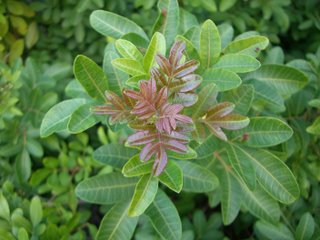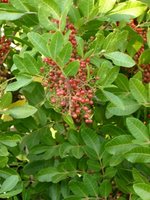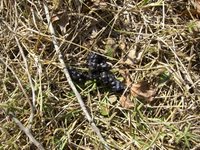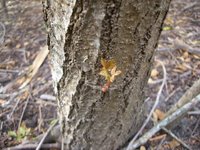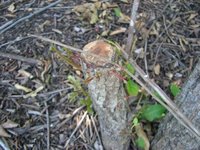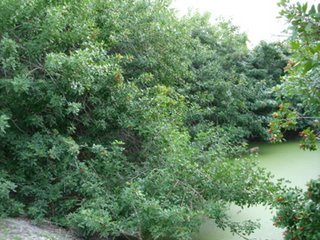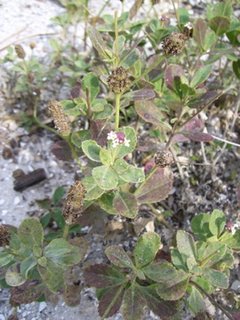 I would dare you to discover a square meter of disturbed, unmanaged land in Florida (or across the south) not covered in a layer of turkey tangle fogfruit, a.k.a. capeweed (Phyla nodiflora). I feel it crunch under my feet whenever I pass a particular stretch of lawn where exotic grasses have given way to this persistent ground herb - neglect, the retreat of herbicides, something different happened here - and I can hear when other people walk through fogfruit patches as well. It is not a succulent, but it is thick-skinned. The USDA claims it to be fire and draught resistent, and I have no reason not to believe them. It is strong and fast, as a plant; I have seen it climb a 50 foot mountain of fill and present a stable ground cover faster than erosion could do its dirty work and wear the pile down. It acts as a pioneer species in places where land has been moved, turned over, dumped, removed, or otherwise (mis)handled. I know purists who call it "worthless." It is not necessarily a native, although it lives from Florida to California across a southern band of North America. It lives there doing this work, being uneventful and unnoticed, unheralded where not altogether spited. Pulled up, its rhyzomy ivy-like structure reveals a matte, showing the whole ground in one interconnected weave of slightly hairy stalks. Each plant produces these delightful little bursts of flower, delicate white petals barely hanging on to a bulbous flower head, thick leaves, purplish-red and dark green. Ubiquitous where we inhabit the south; you may step on one today if you live here. The fogfruit is always ready to put down root, lurking and waiting for our next move. Benignly covering and protecting our sandy soil poured upon intermittently by torrents of desalinized ocean water, water purified by the atmosphere and dumped in buckets. The fogfruit grows, in part, so we do not have to worry; it holds back the true consequences of our actions. And, still, we curse its presence in our lawns and do not even bother to learn its delightfully melodious name as our soles crunch against its persistence and our sprays strangle another tangled patch to death.
I would dare you to discover a square meter of disturbed, unmanaged land in Florida (or across the south) not covered in a layer of turkey tangle fogfruit, a.k.a. capeweed (Phyla nodiflora). I feel it crunch under my feet whenever I pass a particular stretch of lawn where exotic grasses have given way to this persistent ground herb - neglect, the retreat of herbicides, something different happened here - and I can hear when other people walk through fogfruit patches as well. It is not a succulent, but it is thick-skinned. The USDA claims it to be fire and draught resistent, and I have no reason not to believe them. It is strong and fast, as a plant; I have seen it climb a 50 foot mountain of fill and present a stable ground cover faster than erosion could do its dirty work and wear the pile down. It acts as a pioneer species in places where land has been moved, turned over, dumped, removed, or otherwise (mis)handled. I know purists who call it "worthless." It is not necessarily a native, although it lives from Florida to California across a southern band of North America. It lives there doing this work, being uneventful and unnoticed, unheralded where not altogether spited. Pulled up, its rhyzomy ivy-like structure reveals a matte, showing the whole ground in one interconnected weave of slightly hairy stalks. Each plant produces these delightful little bursts of flower, delicate white petals barely hanging on to a bulbous flower head, thick leaves, purplish-red and dark green. Ubiquitous where we inhabit the south; you may step on one today if you live here. The fogfruit is always ready to put down root, lurking and waiting for our next move. Benignly covering and protecting our sandy soil poured upon intermittently by torrents of desalinized ocean water, water purified by the atmosphere and dumped in buckets. The fogfruit grows, in part, so we do not have to worry; it holds back the true consequences of our actions. And, still, we curse its presence in our lawns and do not even bother to learn its delightfully melodious name as our soles crunch against its persistence and our sprays strangle another tangled patch to death.In this, we are merely blinded, not bloodthirsty. We have simply neglected something; the fogfruit will forgive us easily and go on with its work. It is more a loss of delight than the destruction of something vital. Which, if only had been the case in other matters, may not have left me so deeply sullen this last day of 2006, this fourth year of this arrogant and thoughtless war, this second day of murder on the front page, this shameful, shameful fall from humanity. I do not care how angry this may make you; the hanging of Saddam Hussein was a bloodthirsty act and we should be ashamed to have been a part. Nothing of value is served by the spectacle, no one is saved, nothing is ended, vengance is perpetrated and the near certainty of savage warfare into the forseeable future is cast. It was wrong. It was foolish. More, it was evil. We did not neglect an experience benignly, or blindly in this bloodthirsty act. We let our instinct exceed our reason, we killed in full view of the television and for two days now we trot out these images as if they serve to symbolize anything but the bloodthirstiness of anger. Where is our sense, where is our reason, where is our humanity? Who have we become that we openly sanction murder, that we celebrate it in headlines and torrid descriptions of the death ceremony? I am ashamed for the United States, for my country of birth, for this great experiment in human self-rule that seems to be proving that power without education, capital without humanity, aristocracy without obligation, has no right to call itself civilized. The Bushes exposed this dirtly little secret about United States power; they cultivated it as an artform and shamed us all. And, so I wish for a fogfruit of humanity in 2007. I pray to the universe for all of us to notice how we too form an interlaced matte holding the fragile sands of power in place. They would have us forget, distract us with howls of vengance, tickle our worst emotions. In the year ahead, may we remember.
